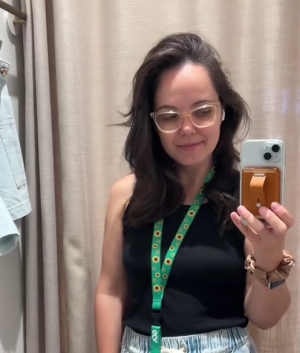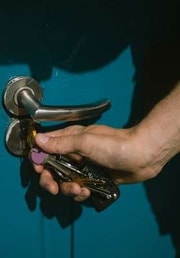Mum uncovers game-changing airport feature for travellers with hidden disabilities
By
Gian T
- Replies 1
Navigating busy public spaces can be challenging for many, and the difficulties are even greater for some.
The fast-paced environment and crowds can feel overwhelming when specific needs aren’t immediately apparent.
Yet, an encouraging development provides a subtle yet impactful way to seek support in these spaces.
Dr Kristyn Sommer, a developmental psychology academic at Griffith University, recently brought attention to this little-known feature that's transforming travel for individuals with hidden disabilities.
On her journey from Queensland's Gold Coast to Sydney, Kristyn donned a green lanyard adorned with daisies, a simple accessory that communicated her autism diagnosis to airport staff, indicating that she might require extra assistance.
'I’ve had an autism diagnosis for a couple of years,' she said.
The green lanyard is part of a nationwide program that Australian airports have quietly adopted following its successful introduction at Gatwick Airport in the UK in 2016.
The sunflower lanyard initiative was developed in consultation with charities to help those with non-obvious disabilities.
The sunflower symbolizes confidence, growth, and strength, and wearing the lanyard allows travellers to discreetly inform staff that they may need a helping hand, patience, or a bit more time.
Kristyn's experience with the program at Gold Coast Airport was nothing short of 'phenomenal.'
After applying for a pack through the airport's website the night before her trip, she easily received her green lanyard and additional informational tools.
The airport staff's response was a testament to their specialized training in recognizing the sunflower symbol and understanding hidden disabilities.
The program doesn't just stop at lanyards. It includes a range of tools, such as terminal sensory maps, communication boards, and an airport activity book.
Gold Coast Airport has even introduced a therapy dog initiative, where trained volunteer therapy dogs visit the terminal to provide comfort to travellers.
Despite some initial self-consciousness, Kristyn plans to use the lanyard again for her international travels later in the year.
She believes that the program puts travellers with hidden disabilities on equal footing with others rather than offering a way to skip lines or rush through the airport.
The community's response to the Hidden Disabilities program has been overwhelmingly positive.
The initiative plays a crucial role in raising awareness and fostering open conversations about accessibility in travel.
After Kristyn shared her experience online, the video went viral, reaching millions and highlighting that many people are still unaware of the program's existence.
Critics who misunderstood the purpose of the lanyard accused Kristyn of seeking to bypass queues, but she clarified that the program's goal is to provide equal access and understanding, not to expedite travel.
The sunflower lanyard initiative is a shining example of how simple measures can significantly improve the lives of those with hidden disabilities.
It reminds us that inclusivity can be woven into the fabric of our everyday experiences, making the world a more accessible place for everyone.
For our readers who may benefit from this program, we encourage you to explore the availability of the sunflower lanyard at your local airport before your next trip. It could very well improve your travel experience.
Credit: TikTok
 Have you or someone you know used the sunflower lanyard or similar initiatives during your travels? We'd love to hear about your experiences and how it impacted your journey. Share your stories in the comments below.
Have you or someone you know used the sunflower lanyard or similar initiatives during your travels? We'd love to hear about your experiences and how it impacted your journey. Share your stories in the comments below.
The fast-paced environment and crowds can feel overwhelming when specific needs aren’t immediately apparent.
Yet, an encouraging development provides a subtle yet impactful way to seek support in these spaces.
Dr Kristyn Sommer, a developmental psychology academic at Griffith University, recently brought attention to this little-known feature that's transforming travel for individuals with hidden disabilities.
On her journey from Queensland's Gold Coast to Sydney, Kristyn donned a green lanyard adorned with daisies, a simple accessory that communicated her autism diagnosis to airport staff, indicating that she might require extra assistance.
'I’ve had an autism diagnosis for a couple of years,' she said.
The green lanyard is part of a nationwide program that Australian airports have quietly adopted following its successful introduction at Gatwick Airport in the UK in 2016.
The sunflower lanyard initiative was developed in consultation with charities to help those with non-obvious disabilities.
The sunflower symbolizes confidence, growth, and strength, and wearing the lanyard allows travellers to discreetly inform staff that they may need a helping hand, patience, or a bit more time.
Kristyn's experience with the program at Gold Coast Airport was nothing short of 'phenomenal.'
After applying for a pack through the airport's website the night before her trip, she easily received her green lanyard and additional informational tools.
The airport staff's response was a testament to their specialized training in recognizing the sunflower symbol and understanding hidden disabilities.
The program doesn't just stop at lanyards. It includes a range of tools, such as terminal sensory maps, communication boards, and an airport activity book.
Gold Coast Airport has even introduced a therapy dog initiative, where trained volunteer therapy dogs visit the terminal to provide comfort to travellers.
Despite some initial self-consciousness, Kristyn plans to use the lanyard again for her international travels later in the year.
The community's response to the Hidden Disabilities program has been overwhelmingly positive.
The initiative plays a crucial role in raising awareness and fostering open conversations about accessibility in travel.
After Kristyn shared her experience online, the video went viral, reaching millions and highlighting that many people are still unaware of the program's existence.
Critics who misunderstood the purpose of the lanyard accused Kristyn of seeking to bypass queues, but she clarified that the program's goal is to provide equal access and understanding, not to expedite travel.
The sunflower lanyard initiative is a shining example of how simple measures can significantly improve the lives of those with hidden disabilities.
For our readers who may benefit from this program, we encourage you to explore the availability of the sunflower lanyard at your local airport before your next trip. It could very well improve your travel experience.
Credit: TikTok
Key Takeaways
- An Australian mother with a hidden disability has highlighted the benefits of using a green lanyard with daisies, an initiative adopted by airports to assist those needing additional support.
- Dr Kristyn Sommer, a developmental psychology academic with autism, praised the simple process and the outstanding support provided by Gold Coast Airport staff.
- The green sunflower lanyard program was introduced in 2019 to create an inclusive environment in airports and includes additional tools such as a sensory map and therapy dogs.
- The initiative, which originated at Gatwick Airport in the UK, allows individuals with hidden disabilities to discreetly inform staff of their needs, promoting confidence, growth, and strength.








